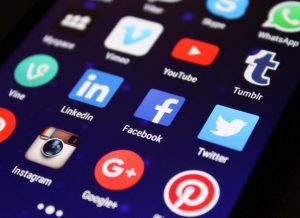By: Amanda Carroo & Alli Berry
Dissecting the state of Content Marketing is no small chore.
The beginning of a new year is always so refreshing. A new start. A time to start planning how to tackle your biggest goals for the year. We hope that developing high-quality content to attract and convert more customers for your business is a priority on that 2018 list. If it is, read on. If it isn’t, you should still give the below a read, it may change your mind.
Every year, Content Marketing Institute releases their upcoming year’s predictions. This year, the release included 60 predictions from some of content marketing’s top thought leaders! (Here is the content marketing predictions list). Amanda and Alli, our fearless leaders in content at Two Octobers, went through all 60 of those predictions and have broken them down into a more digestible format with our own commentary on what we think will matter most for your website and brand in 2018.
Content Strategy
Alli says…
Up until recently, content marketing has been thought of primarily as a tactic for the top of the sales funnel. It is a way for brands to provide useful, informational content to prospective customers while also building trust and authority for the brand. It is also a way to target more relevant keywords and increase qualified organic traffic. And it works beautifully in this capacity.
Joe Lazauskas, Director of Content Strategy at Contently, predicts that content marketing will become more commonplace for brands to utilize it at all stages of the sales funnel. He argues that brands will finally figure out “content is the golden thread that connects every experience in the customer journey” and content marketing will start to be utilized in materials like sales decks and case studies as well.
This is such an important point — compelling, authentic stories sell your products. Content marketing principles can be applied to any content your brand produces. Sales pitches are significantly more effective when real successes are shared. Product content that makes consumers more confident in their potential purchase helps drive conversions. It will be exciting to see how much more middle and bottom-of-funnel content we produce for clients in 2018.
Switching gears a little… you can’t talk about content strategy and not talk about documentation. One of the most important predictions of 2018 to me is that brands will finally document their content marketing strategies. Heidi Cohen, Chief Content Officer of Actionable Marketing Guide, predicts that content marketers will document their content marketing strategy and distribute it across their organization or get left behind. This isn’t a new concept by any means, but with more and more brands entering the content marketing space, it is more important than ever to execute it well. Creating mediocre content won’t cut it anymore.
A study by Content Marketing Institute a few years ago revealed that 60% of organizations with a documented strategy consider their content efforts effective compared to only 32% of organizations with a verbal strategy. It surprises me that this isn’t more lopsided, honestly, because the process of documenting your strategy helps to ensure that all stakeholders are on the same page with the strategy. We recently underwent this process with Two Octobers and just having everyone in one room working together to agree on elements of the strategy has helped better align us all. If you don’t have a documented content strategy yet, we are able and willing to help!
Content Tactics
Amanda says…
Once the strategy and big picture thinking has been done, the real work begins. (Not that defining a strategy isn’t work!) Bringing to life those ideas and implementing them is key to the success of your campaigns. This year, the focus is on high-quality pieces. Whether you’re writing a blog, a gated piece of content or a how-to list, it needs to involve research and key takeaways. We’ve all been served and are familiar with pieces of content with a headline similar to, “The 6 Best Dinosaurs.” You click, you read the list, but who judged this list, what qualities and skills were assessed when ordering these wonderful reptiles? By the end, you’re either happy your dinosaur made the list or, your mad about the choices, and need more than descriptions on why each one was chosen. (Side note, brontosaurus is always #1 in my heart.)
Dan Hatch, the Managing Editor at Lush Media, predicted that the short attention span is over and 2000-word blogs won’t cut it. We’ll be looking for 5,000- and 10,000-word e-books as well as “how-to” guides offering deep insights. As stated above, I think this prediction hits the nail on the head. The real trick for companies will be allowing their content team time to turn around these lengthy, research-heavy pieces.
If I haven’t driven home the original, quality concept enough, “74% of B2B buyers consider original research from brands to be influential in their purchasing process.” This was a stat from Michelle Linn, the Editorial Strategy Advisor at Content Marketing Institute. This further proves that people want original, innovative pieces including a foundation from which learnings can be discovered. If anything, the current lack of this type of content will only make the good pieces stand out even more and will help position you as a thought leader.
Audience-Focused Content
Alli says…
There were eight different predictions that touched on creating content that is more audience-centric. Competition is getting fiercer every year in the content space, which means that brands need to double down on quality of content over quantity, and make their content more relevant to their audiences.
Stephanie Stahl, General Manager of Content Marketing Institute, predicts that to stand out, there needs to be “more emphasis on great writing — more creative, more personal, and even more dramatic, in some cases — to help build loyal audiences.” George Stenitzer, Founder of Crystal Clear Communications, echoes this sentiment predicting that content marketing winners “will listen intently to buyers’ questions and weave teaching into their companies’ DNA.”
Both of these quotes really emphasize the importance of finding your brand’s unique angle. Your content needs to be different from what is already out there and it also needs to resonate with your target audience. Those are going to be keys to success. Listening to buyers’ questions and telling more personal stories to the brand are ways to ensure your content is unique because no one is asking the exact same questions as your buyers and no other brand has your stories. It also will ensure your content resonates and adds value for your audience.
One prediction that feels very timely to what is going on with the world has to do with “fake news” and authenticity. David Meerman Scott, Marketing Strategist at Freshspot Marketing, predicts, “In a world of increasing scandal (think Wells Fargo) and people slapping ‘fake news’ labels on content with increasing frequency, success will come from telling the truth. Always.” People are becoming increasingly skeptical of sources they get their information from. This means that brands, in particular, will need to do an exceptional job of producing authentic and truly helpful content – not content that is solely self-serving. Much like journalism, content from brands should come with data to back up claims.
Content Formats
Alli says…
I struggle a little with content format talk and predictions. I truly believe the only thing that matters with your content format selection is your audience. Meet your audience where they already are. If they are podcast listeners, a podcast makes sense. If they are blog readers, create written posts. I also am a firm believer that you are better off providing consistent content in one or two formats than spreading your brand too thin by trying to produce content in all the formats.
Branching out into new formats should be done slowly and with testing to see how it resonates. There’s always a lot of noise about the next big formats and technologies. Right now it’s all about automation and new technology like the Internet of Things, chatbots, Alexa, and Google Home. It’s good to stay on top of the trends, and sometimes it makes sense to follow them, but only if it works for your audience and goals.
All this being said, I do agree strongly with one prediction from Julie Fleischer, VP of Marketing at Neustar, who said “2018 will reward predictive, personalized, frictionless content.” Creating a one-to-one relationship with a customer is important. What does that really mean? It means providing them with the content they need when they need it. It could come in the form of drip campaigns, where once someone downloads a piece of content, they are served content that comes next in their journey. It could come as a newsletter or a podcast. What matters is that the customer feels that the brand knows exactly what they need and delivers it consistently.
Social Amplification
Amanda says…
I’m sure by this point you have pretty much identified that the thread running consistently through each of these topic areas is original, audience-specific content trumps all. That same thought will continue here. (Didn’t see that coming did you?!)
Facebook’s recent announcement to change to the news feed algorithm to favor friends and family only drives home the need for brands to create content that is worth sharing or talking about. Or, find a way to talk to individuals when then they need it, think chatbots and messenger ads. Arnie Kuenin, CEO of Vertical Measures, It really highlights the main need, which is that brands need to spend the time to understand their customer’s journey and meet them where they are with the right content. Brands need to make sure the content breaks through the clutter with the information or message the client needs and wants.
This also means that the type of content will need to be assessed and diversified. Michael Stelzner pointed out that Facebook’s attachment to video content is only getting stronger. Buzz has been circulating around the company providing resources for businesses to develop more video and Facebook has plans to create a television network in the near future.
So, as we move into 2018, virality and reach are not going to see the same kind of numbers unless the content is extremely shareable or conversation worthy. What will really stand out is unique content, an empathetic approach and a true understanding of who your audience is and what kind of message resonates with them.
Search + Content
Alli says…
There was one key prediction related to SEO and content marketing that feels right on to me. Andy Crestodina, founder of Orbit Media, said:
“I predict lower website traffic in 2018, especially from search. Google is filling search results pages with so many ‘SERP features’ that around half of all clicks are on Google products (maps, images, YouTube) or Google ads. They are doing a better job of keeping their visitors. That means a decline in click-through rates from organic search and fewer visits for websites.”
Let’s unpack this a little. For the last few years, Google has been filling the search engine results pages with features like maps, images, featured snippets, and carousel results. This has kept more visitors from clicking through to other websites because the results pages have often provided the information the user needs right there.
While this could be seen as worrisome for search marketers, there is still a lot of opportunity to grow search traffic. It is important for SEO professionals to pay attention not only to search volume, but also to the competition for each search query and the click-through-rate results from it. In addition, finding search queries that have the potential for a featured snippet or answer box are another way to grow organic traffic in a big way. This particular prediction means that if you employ SEO professionals, it is important that you find ones that are diligent in their research and strategy. Otherwise, you are likely to participate in the trend of declining organic traffic.
Influencer Marketing
Amanda says…
Influencer marketing has a lot of buzz right now, but what does influencer marketing really mean? First off, what constitutes an influencer? Do they have a large following on Instagram or Youtube? Are they a celebrity? Any of the above are correct, and brands are looking for the biggest bang for their buck and in the right market. There are quite a few platforms that match brands with influencers to help said brands reach a qualified audience. This has worked in the past, but I think we’re going to start to see a shift in the year to come. Why? Well, the space is becoming pretty noisy. As Buddy Scalera, Senior Director Content Strategy, The Medicines Company, predicted, “We’ll see brands shift from aggressive outbound campaigns to evangelist enablement strategies.”
In a matter of minutes, anyone can purchase hundreds to thousands of followers on Instagram and get “like” pods to engage with their content. It seems like everyone wants to be an influencer these days, which has unfortunately resulted in a vast amount of “lookalike influencers” that provide a negligible impact. So, as it’s becoming harder for brands to sift through the possibilities, I see them moving away from investing all their money in a few large accounts and really trying to find those needle in the haystacks, those true brand evangelists. Maybe the influencer’s network isn’t 1.2 million deep, but they eat, breath, and sleep loyalty to that brand.
Michael Brenner, CEO, Marketing Insider Group noted that company employees would be the greatest source of distribution. I both agree and disagree with his view. Here’s why – if an employee loves the company they work for, the company treats their people well, offers perks, and sells a great product, then yes, utilize the company’s employees as influencers. There is a true opportunity to help employees become a brand’s biggest marketing tools. But, if, companies think they’re going to get their employees to shout the brand from the rooftop and the company doesn’t put them first, why would an employee go out of their way?
To quote an article from Fortune, “Many CEOs love to talk about the importance of their employees. “Our people are our greatest asset,” is an all-too-familiar phrase. But very few executives manage to translate such words into action.” Maybe, just maybe, companies will catch on to this and evaluate their position and what changes (if any) they need to make to make sure they are taking advantage of their largest, and cheapest, brand ambassadors.
And that’s a wrap on our 2018 content marketing predictions analysis! Still with us? If you’re looking for any help developing or executing a content marketing strategy, both Amanda and Alli are here to help!







